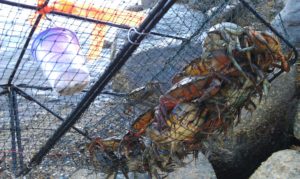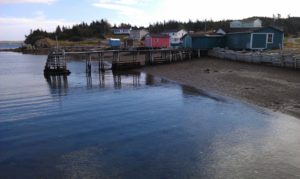Master of All Trades:
Thermal adaptation in invasive green crabs

Invasive European green crabs (Carcinus maenas) being trapped in central Maine.
The European green crab (Carcinus maenas) has been highly successful across a wide gradient of thermal environments in its native and invasive ranges. As such, the species may provide a template for the mechanisms underpinning success in a rapidly changing climate. We use this species as a model for rapid adaptation in the sea, combining macrophysiology and high-throughput sequencing to examine how green crabs adapt to new environments, and how quickly they do it.

North Harbour in Placentia Bay, Newfoundland, where invasive green crabs have become a serious threat to local small-scale fisheries.
Funding Agencies
Current work on the West Coast is funded by the National Science Foundation.
Earlier research was supported by a National Science Foundation Doctoral Dissertation Improvement Grant (1210057), the Partnership for the Interdisciplinary Study of Coastal Oceans, the Myers Trust, the Explorer’s Club Exploration Fund, the Lerner Gray Memorial Fund of the American Museum of Natural History, the Vice Provost for Graduate Education at Stanford, and the Eugene C. and Aileen Haderlie Memorial Fund. During graduate school, CKT was supported on this project by a National Defense Science and Engineering Grant, a Stanford Graduate Fellowship, and a Stanford Center for Computational, Evolutionary, and Human Genomics Fellowship.

Partners/Collaborators
Most recently, we have been working extensively on the West Coast with Washington Sea Grant's Crab Team, led by Jeff Adams, Emily Grason, and P. Sean McDonald. We also have an extensive network of collaborators along the coast who have been instrumental to this project.
Initial West Coast work is currently underway in collaboration with Greg Ruiz of the Smithsonian Environmental Research Center, Ted Grosholz of UC Davis, and Cat de Rivera of Portland State University.
This area of research began as CKT's doctoral dissertation with Steve Palumbi and George Somero of Stanford's Hopkins Marine Station.
